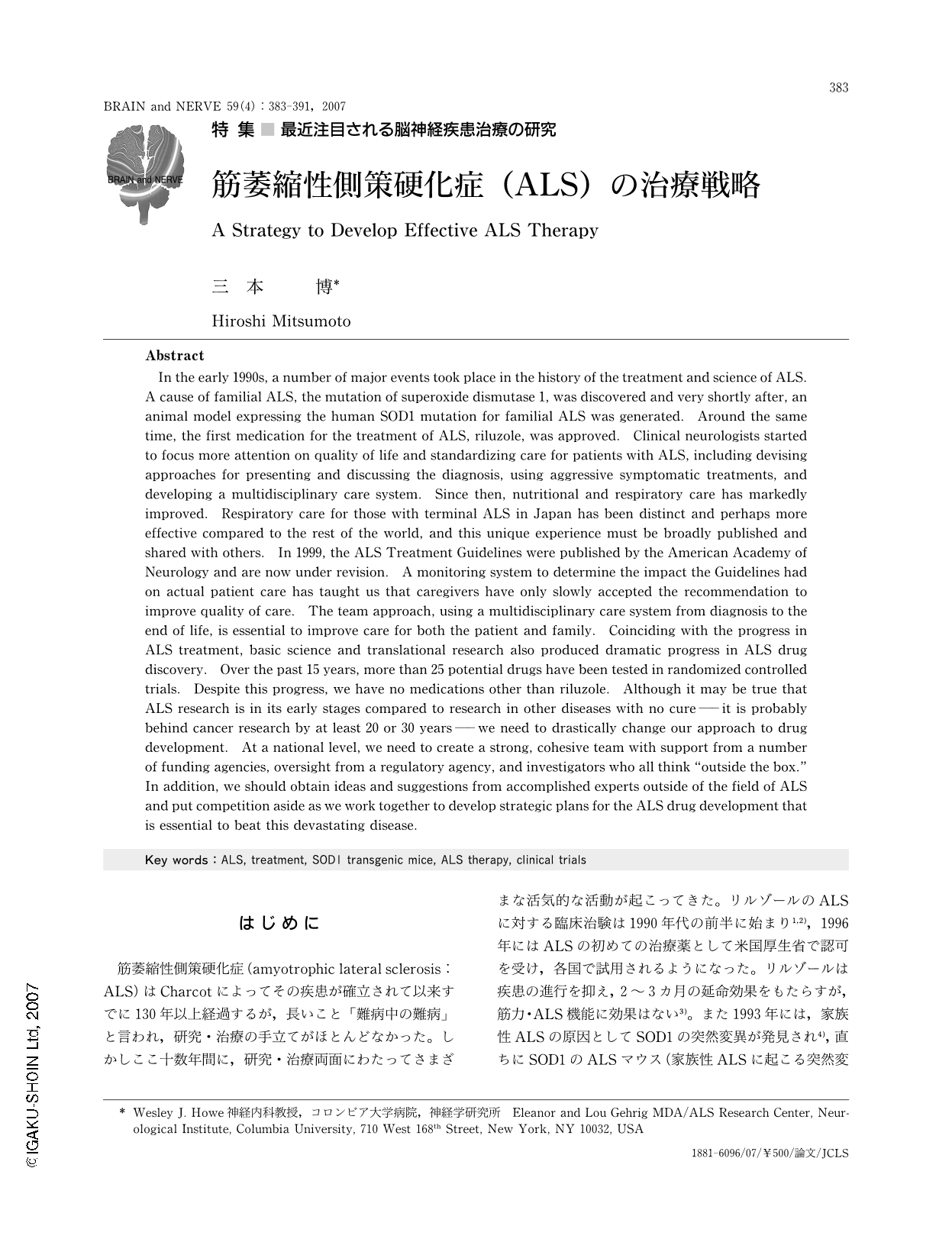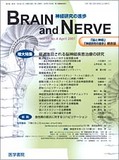Japanese
English
- 有料閲覧
- Abstract 文献概要
- 1ページ目 Look Inside
- 参考文献 Reference
はじめに
筋萎縮性側策硬化症(amyotrophic lateral sclerosis:ALS)はCharcotによってその疾患が確立されて以来すでに130年以上経過するが,長いこと「難病中の難病」と言われ,研究・治療の手立てがほとんどなかった。しかしここ十数年間に,研究・治療両面にわたってさまざまな活気的な活動が起こってきた。リルゾールのALSに対する臨床治験は1990年代の前半に始まり1,2),1996年にはALSの初めての治療薬として米国厚生省で認可を受け,各国で試用されるようになった。リルゾールは疾患の進行を抑え,2~3カ月の延命効果をもたらすが,筋力・ALS機能に効果はない3)。また1993年には,家族性ALSの原因としてSOD1の突然変異が発見され4),直ちにSOD1のALSマウス(家族性ALSに起こる突然変異型SOD1G93Aをマウスに発現させた動物モデル)が作製され,ALSに対する基礎研究が急速に進歩した5)。こうしたALSにおける一連の新しい動きは,リルゾールに引き続き,ALSの治療薬が続々と開発されるだろうと期待された。しかるに,十年以上たった現在,リルゾールに続く第二の治療薬はまだ開発されていない。
一方,リルゾールの認可と時を同じくしてALSの治療・ケアに対してもさまざまな方向から改善の目が向けられ,加速度的な進歩がみられるようになった。ALSの治療というと,まずわれわれ医師が行う患者個人への治療を指すが,さらに,治療全体を改善する研究,ALS医療システムの改善,さらに治療薬開発のための臨床治験,緊急を要する治療薬開発のための研究など,幅広い領域に及んでいる。したがって,強力なチームワークなくして,ALS治療の成功は考えられない。ここでは戦略的な立場からALSの治療全般にわたって言及し,さらに将来の方向付けを試みたい。
Abstract
In the early 1990s, a number of major events took place in the history of the treatment and science of ALS. A cause of familial ALS, the mutation of superoxide dismutase 1, was discovered and very shortly after, an animal model expressing the human SOD1 mutation for familial ALS was generated. Around the same time, the first medication for the treatment of ALS, riluzole, was approved. Clinical neurologists started to focus more attention on quality of life and standardizing care for patients with ALS, including devising approaches for presenting and discussing the diagnosis, using aggressive symptomatic treatments, and developing a multidisciplinary care system. Since then, nutritional and respiratory care has markedly improved. Respiratory care for those with terminal ALS in Japan has been distinct and perhaps more effective compared to the rest of the world, and this unique experience must be broadly published and shared with others. In 1999, the ALS Treatment Guidelines were published by the American Academy of Neurology and are now under revision. A monitoring system to determine the impact the Guidelines had on actual patient care has taught us that caregivers have only slowly accepted the recommendation to improve quality of care. The team approach, using a multidisciplinary care system from diagnosis to the end of life, is essential to improve care for both the patient and family. Coinciding with the progress in ALS treatment, basic science and translational research also produced dramatic progress in ALS drug discovery. Over the past 15 years, more than 25 potential drugs have been tested in randomized controlled trials. Despite this progress, we have no medications other than riluzole. Although it may be true that ALS research is in its early stages compared to research in other diseases with no cure―it is probably behind cancer research by at least 20 or 30 years―we need to drastically change our approach to drug development. At a national level, we need to create a strong, cohesive team with support from a number of funding agencies, oversight from a regulatory agency, and investigators who all think “outside the box.” In addition, we should obtain ideas and suggestions from accomplished experts outside of the field of ALS and put competition aside as we work together to develop strategic plans for the ALS drug development that is essential to beat this devastating disease.

Copyright © 2007, Igaku-Shoin Ltd. All rights reserved.


